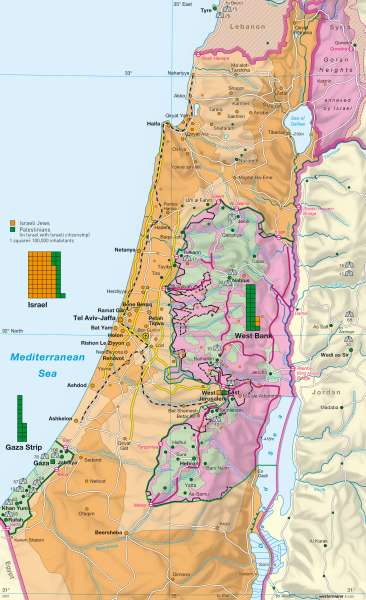Settlement and boundaries
Israel
978-3-14-100790-9 | Page 100 | Ill. 3

Information
The map shows the political boundaries of the settlement structure and population distribution within the state of Israel, Israeli-occupied territories and Palestinian territories of the West Bank and Gaza Strip.The West Bank is a fragmented political region under a peace treaty between Israel and the Palestinians.
The autonomous areas are at the core of the international Middle East peace plan (roadmap) for a future Palestinian state extending to the Gaza Strip and unconnected zones within the West Bank. Of the Jewish settlements, built since 1967 in the occupied territories, the West Bank and East Jerusalem (in the Gaza Strip were evacuated) -are separated Palestinian communities and economies: 1. Through traffic which may not be used by Palestinians; 2. By zones outside the actual area of autonomy, which are mostly controlled by Israel; 3. By fortified border posts between the West Bank and Israeli territory and between Palestinian and Jewish settlements.
Refugee problem
With the proclamation of the state of Israel in May 1948 and the first Arab-Israeli war, there was an initial wave of refugees, especially in to the West Bank, Gaza Strip and surrounding Arab states. The second wave of refugees had its origin in June 1967. After the state of Israel was established, Jewish immigration greatly increased the population, with several influxes of Holocaust survivors from Europe, especially Jews from Yemen, Iraq, Morocco, and later from Egypt. A total of one million people were inhabitants by 1960. Another 900,000 immigrants arrived in the country up until 1988. With the collapse of the Soviet Union, almost one million more immigrants arrived in Israel.
Currently, the State of Israel, including Jerusalem, has approximately 7.2 million inhabitants, 76% of whom are Jews, 20% Muslims and 2% Christians. In the West Bank, some 270,000 Jews live in separate settlements and approximately 200,000 Jewish Israelis in East Jerusalem. Palestinian refugees and their descendants live, among other places, in Jordan, Lebanon and Syria. Of the Palestinians in the West Bank, about 30% of approximately 2.4 million people are refugees or their descendants. There are approximately 1.48 million inhabitants in the Gaza Strip and almost two thirds are registered refugees. With 3,960 inhabitants per square kilometre, the Gaza Strip is also one of the most densely populated regions on earth.
Conflict points are still the focus of Jerusalem (the capital of Israel in 1980 by law) which declared the right of return for Palestinian refugees and the future of Jewish settlements in the occupied territories. Terrorist attacks on Israel were responded to with military strikes, intermittent border closures and the construction of a fortified border post.
A. Wittstock, H. Aubel, E. Astor; Ü: Colette Fleming




